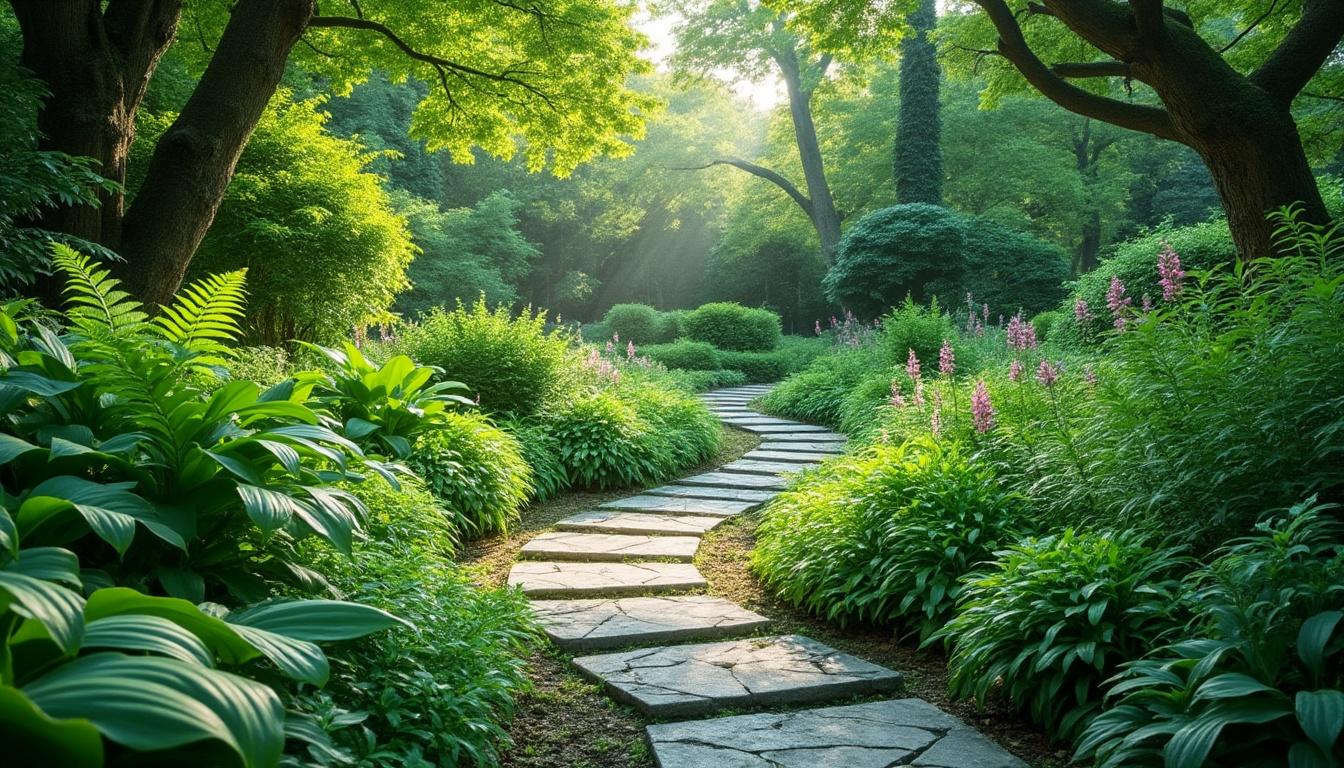In the pursuit of creating serene and exceptionally vibrant outdoor spaces, the gardening technique known as green drenching has risen as a favorite among horticulturists and landscape designers alike. This approach involves saturating a garden with layered, varying shades of green plants, crafting a verdant sanctuary that emphasizes texture, form, and sustainability. Drawing upon principles from established brands like GreenGardens and EcoFlora, green drenching not only enriches the visual appeal but also promotes SustainableStyle, making every garden a paragon of ecological harmony and GardenGlam. The technique’s ability to enhance space aesthetics while supporting environmental values represents an exciting evolution in modern gardening practices.
Understanding Green Drenching: The Foundation of VerdantVisions in Modern Gardens
Green drenching can be described as the artful layering of green foliage in different tones, textures, and growth habits to create a lush, immersive environment. This concept transcends traditional floral-centric landscaping by prioritizing the calming and continuous presence of green over fluctuating blooms. The approach is rooted in the principles of EarthyEssence and LushLiving, emphasizing the longevity and year-round appeal of greenscapes.
Key elements include choosing plants with varying foliage shapes and sizes, such as ferns, evergreen shrubs, grasses, and climbers. The goal is to manipulate visual perception by creating depth and complexity, which also enhances biodiversity and promotes a sustainable garden ecosystem.
Examples of successful green drenching projects are often highlighted by brands like FlourishCo, where plant palettes range from dark glossy leaves to light textured fronds, providing visual intrigue without overwhelming the senses. The use of shade and light plays a critical role, with strategic planting ensuring some greens reflect sunlight vividly while others soften space with muted hues.
- Plant layering: Use tall evergreens for background, mid-height decorative shrubs, and low-growing groundcovers to establish multiple strata of greenery.
- Texture contrast: Mix broad leaves with fine ferny fronds and needle-like conifers to break monotony.
- Color gradient: Incorporate a range of green shades — from deep forest to bright lime — to build dynamic visual appeal.
- Seasonal consistency: Prioritize evergreen species that maintain foliage throughout the year, ensuring year-round interest.
- Water and soil care: EcoFlora advocates for natural fertilization and efficient watering techniques to nurture dense foliage without excess resource consumption.
| Plant Type | Preferred Position | Foliage Characteristic | Maintenance Level |
|---|---|---|---|
| Evergreen Shrubs | Background/Midground | Glossy, dense | Medium |
| Ferns | Mid-ground/Foreground, shaded | Soft, feathery | Low |
| Grass Varieties | Foreground/Border | Fine, flowing | Low to Medium |
| Climbers (Ivy, Vines) | Vertical Structures | Dense, variegated | Medium |
Techniques to Implement Green Drenching for SustainableStyle and EcoFlora Appeal
Incorporating green drenching demands a strategic approach, optimizing both plant selection and placement for maximum environmental and aesthetic benefit. This section explores essential techniques that marry artistic vision with the tenets of sustainability championed by entities like GreenGardens and NatureNest.
Firstly, baseline soil health evaluation is imperative. Rich organic content supports vigorous green growth, reducing the need for synthetic fertilizers and aligning perfectly with SustainableStyle principles. Amendments such as compost or worm castings can infuse vital nutrients naturally.
Plant spacing plays a pivotal role as well. While the green drenching effect prefers dense planting to create continuity, careful consideration is necessary to avoid overcrowding, which can lead to pest issues and poor air circulation. The balance ensures vibrant foliage robust against seasonal changes and supports LushLiving goals of eco-friendly maintenance.
Water management is another critical factor. Techniques such as drip irrigation enable precise watering that maintains the moisture levels plants need without waste. Green drenching gardens typically boast superior water retention when layered correctly, but systemized irrigation further enhances this benefit.
- Soil enrichment: Use organic matter and natural amendments to boost fertility for healthier, more robust foliage.
- Smart plant spacing: Maintain optimal distances to promote airflow and reduce disease incidence.
- Drip irrigation setups: Conserve water while providing consistent moisture to all plant layers.
- Mulching: Apply bark or leaf mulch to retain soil moisture and suppress weeds, enhancing soil life.
- Native plant selection: Emphasize species adapted to local climates to reduce water and nutrient demands.
| Technique | Benefit | Recommended Practices |
|---|---|---|
| Soil Enrichment | Boosts nutrient availability | Add organic compost and maintain pH balance |
| Plant Spacing | Prevents overcrowding and disease | Maintain 12-18 inches distance for most shrubs |
| Drip Irrigation | Efficient water usage | Use timers to schedule frequent short waterings |
| Mulching | Moisture retention, weed control | 3-4 inch layer applied annually |
| Native Plants | Eco-friendly and minimal maintenance | Select species indigenous to your garden zone |
The Role of Plant Diversity in Achieving Green Drenching Mastery with VerdantVisions
One of the most critical elements of successful green drenching is the diversity of plant species incorporated. Unlike traditional gardens that may rely on repetition, a carefully curated mixture promotes a natural, balanced ecosystem aligned with FlourishCo and EarthyEssence methodologies.
Diversity ensures visual richness and resilience. By integrating a broad spectrum of evergreen shrubs, ferns, grasses, and woody climbers, the garden fosters beneficial insect populations and discourages pest outbreaks. This balance contributes to long-term sustainability and the desired GardenGlam aesthetic without heavy reliance on chemical interventions.
Plant diversity is categorized into functional groups:
- Structural plants: Tall evergreens and conifers providing height and privacy.
- Textural plants: Ferns and ornamental grasses adding softness and contrast.
- Ground covers: Low mats and creeping plants that prevent soil erosion and suppress weeds.
- Climbers and vines: Vegetation that utilizes vertical space for additional greenery and dynamic form.
For instance, a thriving green-drenched garden may combine boxwood hedges with Japanese painted ferns and native sedges, supplemented by climbing ivy on trellises. This mixture not only delivers aesthetic depth but also enhances ecological balance.
| Plant Group | Example Species | Visual Contribution | Ecological Role |
|---|---|---|---|
| Structural Plants | Boxwood, Juniper | Vertical height, shape | Windbreak, Shelter |
| Textural Plants | Ferns, Blue Fescue | Softness, layering | Habitat for beneficial insects |
| Ground Covers | Periwinkle, Creeping Thyme | Low-level greenery, weed prevention | Soil protection, moisture retention |
| Climbers and Vines | English Ivy, Clematis | Vertical coverage, texture | Supports pollinators |
Design Principles for Creating a Green Drenched Garden with GardenGlam Appeal
A garden drenched in layers of green calls for meticulous design to achieve harmony and elegance. GardenGlam’s principles emphasize blending form with function, underlining how every plant and element contributes to an inviting, tranquil space.
Key design tactics involve:
- Repetition of elements: Employ recurring textures and colors, fostering continuity and rhythm.
- Focal points: Integrate sculptural plants or natural features like moss-covered stones to anchor the visual flow.
- Contrast of shapes: Juxtapose rounded shrubs with spiky grasses to create dynamic movement.
- Layer transitions: Ensure smooth changes between low, mid, and high plant strata for a cohesive palette.
- Use of negative space: Strategically leave breathing room to avoid visual clutter and highlight plant qualities.
In practice, designers working under the SustainableStyle ethos often combine native shrubs with ornamental grasses and trailing plants such as vinca vines to establish lush, yet functional green canvases. The goal is to nurture spaces evocative of NatureNest sanctuaries where visitors feel enveloped by peace and vitality.
| Design Principle | Application | Effect |
|---|---|---|
| Repetition | Use clusters of the same plant species or color | Creates rhythm and unity |
| Focal Points | Introduce standout plants or natural features | Directs viewer attention |
| Shape Contrast | Pair round shrubs with linear grasses | Adds visual interest and movement |
| Layer Transition | Smooth gradients between plant sizes | Enhances harmony and balance |
| Negative Space | Open gaps between groupings | Prevents overcrowding and showcases plants |
Maintenance Strategies to Sustain the Richness of Green Drenched Gardens with FlourishCo Expertise
Achieving a green-drenched sanctuary is a significant step, but sustaining its rich allure requires consistent, informed maintenance strategies. FlourishCo specialists recommend practices designed to uphold the lush vibrancy and health of these gardens without compromising eco-conscious values.
Maintenance tasks include routine pruning to preserve plant shape and health. This also reduces overcrowding, thus maintaining optimal airflow and sunlight exposure, both of which support lush foliage growth. Soil testing throughout the season ensures nutrient levels remain balanced, supporting sustained vitality in line with EarthyEssence standards.
Integrated pest management is vital, with a preference for natural pest deterrents and beneficial insect encouragement rather than chemical pesticides. Such practices not only respect the SustainableStyle ethos but also protect the intricate ecosystem within a green-drenched garden.
- Regular pruning: Maintain shape and allow air circulation.
- Seasonal soil testing: Adjust fertilization based on nutrient needs.
- Natural pest control: Use companion plants and organic insecticides.
- Water monitoring: Ensure drip irrigation is functioning and adjust according to rainfall.
- Mulch replenishment: Replace mulch to retain moisture and add organic matter.
| Maintenance Task | Frequency | Purpose |
|---|---|---|
| Pruning | Monthly during growing season | Shape retention and health |
| Soil Testing | Biannual | Nutrient balance assessment |
| Pest Control | As needed | Prevent pest outbreaks organically |
| Water System Check | Monthly | Ensures irrigation efficiency |
| Mulch Replacement | Annually | Maintains soil moisture and health |
Frequently Asked Questions About Green Drenching in Gardening
- What types of plants are best suited for green drenching?
Plants with varying textures, heights, and evergreen qualities like ferns, grasses, shrubs, and climbers are ideal to create depth and year-round interest. - How does green drenching contribute to sustainability?
By focusing on perennial greens and native species, green drenching reduces the need for frequent replanting, water, and chemical inputs, supporting eco-friendly gardening. - Is green drenching suitable for small gardens?
Yes, the technique can be adapted for small spaces by using compact plants and vertical gardening to maximize greenery without overcrowding. - How often should maintenance be performed in green-drenched gardens?
Regular pruning and seasonal soil testing, approximately monthly and biannually, respectively, keep the foliage healthy and vibrant while maintaining balance. - Can green drenching improve garden biodiversity?
Absolutely, the plant diversity inherent in green drenching promotes beneficial insects and wildlife, enhancing the garden’s ecological value.

